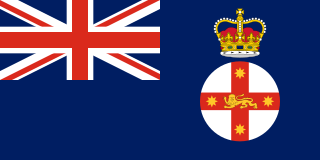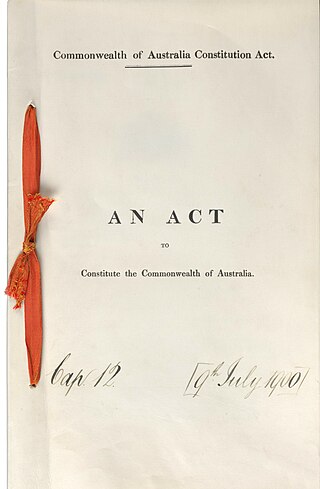
The governor-general of Australia is the representative of the monarch, currently King Charles III, in Australia. The governor-general is appointed by the monarch on the recommendation of the prime minister. The governor-general has formal presidency over the Federal Executive Council and is commander-in-chief of the Australian Defence Force. The functions of the governor-general include appointing ministers, judges, and ambassadors; giving royal assent to legislation passed by parliament; issuing writs for election; and bestowing Australian honours.

The governor of New South Wales is the viceregal representative of the Australian monarch, King Charles III, in the state of New South Wales. In an analogous way to the governor-general of Australia at the national level, the governors of the Australian states perform constitutional and ceremonial functions at the state level. The governor is appointed by the monarch on the advice of the premier of New South Wales, and serves in office for an unfixed period of time—known as serving At His Majesty's pleasure—though five years is the general standard of office term. The current governor is retired jurist Margaret Beazley, who succeeded David Hurley on 2 May 2019.

The Westminster system or Westminster model is a type of parliamentary government that incorporates a series of procedures for operating a legislature, first developed in England. Key aspects of the system include an executive branch made up of members of the legislature, and that is responsible to the legislature; the presence of parliamentary opposition parties; and a ceremonial head of state who is different from the head of government. The term comes from the Palace of Westminster, the current seat of the Parliament of the United Kingdom. The Westminster system is often contrasted with the presidential system that originated in the United States, or with the semi-presidential system, based on the government of France.

The Executive Council of New Zealand is the full group of "responsible advisers" to the governor-general, who advise on state and constitutional affairs. All government ministers must be appointed as executive councillors before they are appointed as ministers; therefore all members of Cabinet are also executive councillors. The governor-general signs a warrant of appointment for each member of the Executive Council, and separate warrants for each ministerial portfolio.

The Federal Executive Council is a statutory body established by Section 62 of the Australian Constitution to advise the Governor-General of Australia, as head of state, on the matters of the federal government. The council comprises, at least notionally, all current and former Commonwealth ministers and assistant ministers. As the Governor-General is bound by convention to follow the advice of the Executive Council on almost all occasions, the Executive Council has de jure executive power. In practice, this power is used to legally enact the decisions already made by Federal Cabinet, due to the practices of the Westminster system making the cabinet a de jure authority in its own right.

The Government of New South Wales, also known as the NSW Government, is the democratic administrative authority in New South Wales, Australia, and is empowered by the state Constitution. Since Federation in 1901, New South Wales has been a state of Australia, and the federal Constitution regulates its relationship with the Commonwealth. Under the Australian Constitution, all states ceded legislative and judicial supremacy, but retained powers in all matters not in conflict with the Commonwealth.

The Australian Government, also known as the Commonwealth Government, is the national government of Australia, a federal parliamentary constitutional monarchy. Like other Westminster-style systems of government, the Australian Government is made up of three branches: the executive, the legislative, and the judicial.

The Parliament of New South Wales is a bicameral legislature in the Australian state of New South Wales (NSW), consisting of the New South Wales Legislative Assembly and the New South Wales Legislative Council. Each house is directly elected by the people of New South Wales at elections held approximately every four years. The Parliament derives its authority from the King of Australia, King Charles III, represented by the Governor of New South Wales, who chairs the Executive Council. The parliament shares law making powers with the Australian Federal Parliament. The New South Wales Parliament follows Westminster parliamentary traditions of dress, Green–Red chamber colours and protocols.
The government of Alberta is the body responsible for the administration of the Canadian province of Alberta. As a constitutional monarchy, the Crown—represented in the province by the lieutenant governor—is the corporation sole, assuming distinct roles: the executive, as the Crown-in-Council; the legislature, as the Crown-in-Parliament; and the courts, as the Crown-on-the-Bench. The functions of the government are exercised on behalf of three institutions—the Executive Council; the Legislative Assembly; and the judiciary, respectively. Its powers and structure are partly set out in the Constitution Act, 1867.

The Vice-President of the Executive Council is the minister in the Government of Australia who acts as the presiding officer of meetings of the Federal Executive Council when the Governor-General is absent. The Vice-President of the Executive Council is appointed by the Governor-General on the advice of the Prime Minister of Australia, and serves at the Governor-General's pleasure. The Vice-President is usually a senior minister in Cabinet, who may summon executive councillors and preside at council meetings when the Governor-General is not present. However, the Vice-President cannot sign Executive Council documents on behalf of the Governor-General.

The government of Ontario is the body responsible for the administration of the Canadian province of Ontario. A constitutional monarchy, the Crown—represented in the province by the lieutenant governor—is the corporation sole, assuming distinct roles: the executive, as the Crown-in-Council; the legislature, as the Crown-in-Parliament; and the courts, as the Crown-on-the-Bench. The functions of the government are exercised on behalf of three institutions—the Executive Council; the Provincial Parliament ; and the judiciary, respectively. Its powers and structure are partly set out in the Constitution Act, 1867.
An executive council is a constitutional organ found in a number of Commonwealth countries, where it exercises executive power and (notionally) advises the governor, governor-general, or lieutenant governor, and will typically enact decisions through an Order in Council. In several Commonwealth countries, the executive council is usually referred to as the cabinet. However, the use of the word cabinet as a synonym for the executive council is not universally practised throughout the Commonwealth of Nations, with some Commonwealth countries using the term cabinet to refer to a distinct group of high-ranking officials.
In Canada, a lieutenant governor is the representative of the King of Canada in the government of each province. The Governor General of Canada appoints the lieutenant governors on the advice of the Prime Minister of Canada to carry out most of the monarch's constitutional and ceremonial duties for an unfixed period of time—known as serving "At Her Excellency's pleasure"—though five years is the normal convention. Similar positions in Canada's three territories are termed "Commissioners" and are representatives of the federal government, not the monarch directly.

The New Zealand Government is the central government through which political authority is exercised in New Zealand. As in most other parliamentary democracies, the term "Government" refers chiefly to the executive branch, and more specifically to the collective ministry directing the executive. Based on the principle of responsible government, it operates within the framework that "the [King] reigns, but the government rules, so long as it has the support of the House of Representatives". The Cabinet Manual describes the main laws, rules and conventions affecting the conduct and operation of the Government.

The Constitution of Australia is the supreme law of Australia. It is a written constitution that sets down the political structure of Australia as a federation under a constitutional monarchy and outlines the structure and powers of the Australian Government's three constituent parts: the executive, legislature, and judiciary.
The Government of Quebec is the body responsible for the administration of the Canadian province of Quebec. A constitutional monarchy, the Crown is the corporation sole, assuming distinct roles: the executive, as the Crown-in-Council; the legislature, as the Crown-in-Parliament; and the courts, as the Crown-on-the-Bench. The powers of the Crown are exercised on behalf of three institutions—the Executive Council (Cabinet); the National Assembly; and the judiciary, respectively.

The Constitution of 1961 was the fundamental law of South Africa for two decades. Under the terms of the constitution South Africa left the Commonwealth and became a republic.
The royal prerogative is a body of customary authority, privilege, and immunity recognized in common law as belonging to the sovereign, and which have become widely vested in the government. It is the means by which some of the executive powers of government, possessed by and vested in a monarch with regard to the process of governance of the state, are carried out.

The Vice-President of the Executive Council of New South Wales is a position in the Australian state of New South Wales governments, whose holder acts as presiding officer of the Executive Council of New South Wales in the absence of the Governor.

The Constitution Amendment (Pledge of Loyalty) Act 2006 No 6, was an Act to amend the Constitution Act 1902 to require Members of the New South Wales Parliament and its Ministers to take a pledge of loyalty to Australia and to the people of New South Wales instead of swearing allegiance to Queen Elizabeth II her heirs and successors, and to revise the oaths taken by Executive Councillors. The Act was assented to by the Queen on 3 April 2006.













